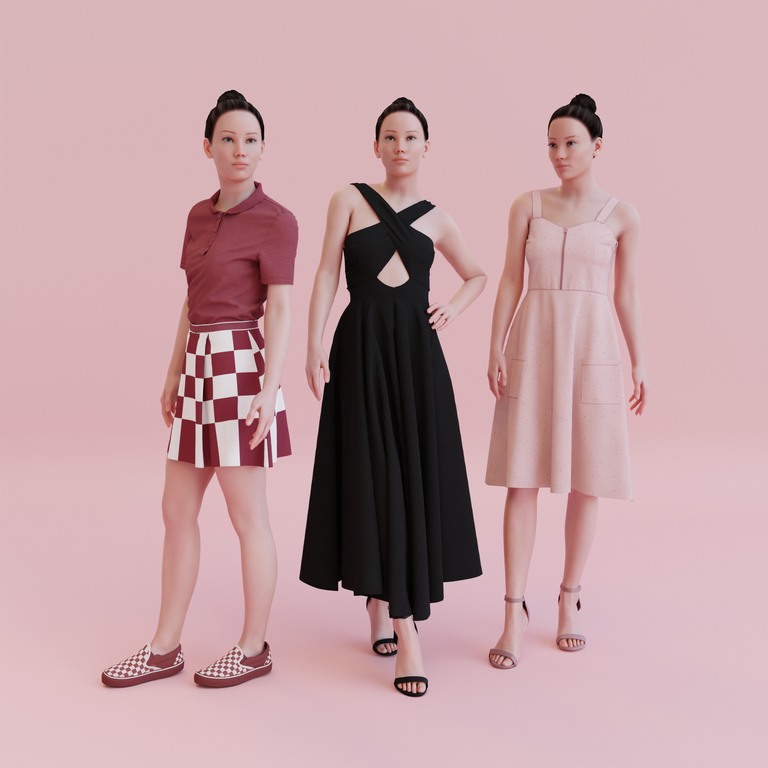"The apparel industry has begun its digital revolution"
3D solutions for fashion design, development and merchandising can not only increase the efficiency of fashion companies, but also reduce the production of physical samples, speed up product development and reduce textile waste -thus helping address the sector's well-publicised sustainability challenge.
What until recently could only be realized in fashion through paper sketches to paper patterns and hand-sewn samples, can now all be rendered in true-to-life 3D thanks to a new generation of design and production technologies.
To learn more about this topic, we talked to Browzwear co-founder and CEO Sharon Lim about the role and importance of 3D technology in the apparel industry.
It is often said that the apparel industry is experiencing a digital revolution. What does this actually mean?
In short, the digital revolution in apparel and fashion is all about reshaping the industry through technological innovation, replacing outdated, longwinded, and wasteful processes with fast, efficient, and sustainable methods. The fashion industry has certainly already begun this revolution; however, some organizations are leaps ahead of others in terms of their progress and openness to change.
Why is a digital revolution needed in the apparel industry?
Fashion continues to be one of the most polluting and wasteful industries anywhere, accounting for up to 10% of global carbon emissions. More and more apparel producers are facing the costs of this environmental footprint, prompting them to make efforts to shift to more sustainable operations, from design to production and selling. Not only does digital innovation help drive sustainability, but it also enables apparel businesses to operate more efficiently and profitably in the long term by reducing -or even eliminating- frequent and unnecessary costs.
Browzwear prides itself in being an innovator in 3D modeling and a pioneering software platform for apparel design, development and merchandising. What does Browzwear offer the apparel industry? Working hand-in-hand with designers and apparel companies of all sizes, Browzwear’s mission is to drive forward the industry’s much-needed digital transformation. Through the powerful combination of its industry-leading 3D design software, VStitcher, advanced visualization capabilities, and expanding Open Platform, Browzwear enables its users to leverage the power of true-to-life 3D technology to build end-to-end digital workflows, from design and development through to marketing and production.
What are the advantages of digital product lifecycle over traditional production methods in apparel production?
There are five clear benefits:
- Get products to market faster by shaving months off the design process
- Streamline processes by utilizing a single solution over multiple, standalone products
- Reduce costs by leveraging digital twins of physical garments
- Cut back on the industry's environmental impact by eliminating physical samples
- Improve product quality through data-driven fit validation
You work with more than 650 companies and manufacturers around the world, including leading apparel brands such as Adidas, Columbia, Nike and VF. What feedback do you get?
Our goal is of course the success of our clients, and we often receive feedback around the companies' ability to enjoy faster and more efficient processes with increased flexibility, from both an environmental and business perspective, ultimately improving their business’s bottom line. In fact, many of our customers find that by shifting to digital they are able to get products to market up to 80% faster.

the validation and completion of the design process throughout the company.
And what about smaller companies and brands, or independent designers? Can they benefit from digital solutions as well?
Yes, we work with a variety of smaller apparel businesses as well as a global community of independent designers who have free access to our 3D design software, VStitcher, through our Indie Program. This gives aspiring digital designers the opportunity to onboard to 3D and master their skills in VStitcher, accompanied by our on-demand learning platform, Browzwear University.
Is there data on how much time and textile waste can be saved when product development goes completely digital?
Halti -a Finnish outdoor brand- reduced its sales samples and carbon emissions by 50%; Pepco -a European retailer- reduced its physical samples for childrenswear by 40%, Crystal Denim -a manufacturer based in Hong Kong- saved 50% of time on its product development cycle and reduced its physical samples and associated waste by 75%. Another Asian manufacturer, Kane Top, shortened its sample development cycle from two weeks to just a day and reduced its physical samples throughout the process by 32%.
One of Browzwear's first products was a virtual fitting room and first 2D-to-3D clothing simulation. Since then, the product portfolio has expanded significantly. What other digital product innovations can be expected in the near future?
We are progressing on our product roadmap, along with upgraded garment showcasing capabilities and digital product creation features and functions, and expanding digital ecosystem of complementary technology solutions to provide apparel organizations with a smooth-running end-to-end workflow. One of our main priorities with this is to enhance the true-to-life digital twin aspect of our software, ensuring that each physical property of a garment is accounted for and replicates its physical form, from its stretch and bend to drape and fit.
In 2020, you launched the digital learning platform Browzwear University. Who is the platform aimed at and what does it offer?
Browzwear University is designed to facilitate apparel companies in accelerating their digital transformation process and expand the influence of 3D within their organizations. The platform provides users with an on-demand learning source to gain all of the essential tools and skills needed to become an accomplished VStitcher user.
What still prevents apparel producers from using digital technologies in this way? How do you convince skeptics?
Many companies that are hesitant to open their doors to 3D still cling to the traditional aspects of apparel design and are nervous to veer away from the physical sampling process. What we bring to the table is the concept of a ‘true-to-life digital twin’ of the physical garments. Through accurate fabric scanning technology and state-of-the-art garment simulation, our users can trust in 3D, and rest assured that what they see on the screen will represent the end result, from the fit to the drape of the garment. That way, everyone involved throughout the design to the development process, can rely on a single source of truth. Not only does digital technology allow for better collaboration and communication between brands and manufacturers, but working with digital technology minimizes the chances of common errors and misunderstandings throughout the process, as they are working off accurate and advanced visual tools based on real-life measurements.
Browzwear will soon open training centers in Dongguan, China and Dhaka, Bangladesh. What is the idea behind this and what opportunities will it bring?
The initiative with featuring LIMITED is designed to enable employees of manufacturers and suppliers as well as individual designers, pattern-makers, technical designers and others to become proficient in the latest 3D technology and its application to product design and development. The facilities, called Digi-hubs, will provide invaluable upskilling and peer-to-peer sharing in the garment industry in both manufacturing-heavy regions.
About Browzwear
Founded in 1999, Browzwear is a pioneer of 3D digital solutions for the fashion industry, driving seamless processes from concept to commerce. Worldwide, more than 650 organizations such as Columbia Sportswear, PVH Group and VF Corporation leverage Browzwear’s open platform to streamline processes, collaborate, and pursue data-driven production strategies.

